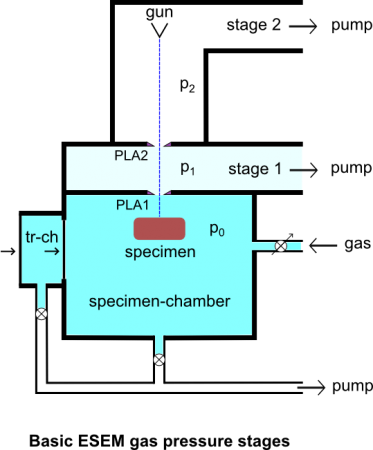
Basic ESEM gas pressure stages, by Gerry Danilatos.
The Department of Defense (DoD) announces the Fiscal Year 2023 Defense University Research Instrumentation Program (DURIP). I’m excited to share that the 2023 DURIP selections have been announced and our proposal for a new Environmental Scanning Electron Microscope is recommended for award. All indications are that it will be funded. Congratulations to Dr. Bruce Lee (PI), Dr. Paul Sanders, Dr. Trisha Sain, Dr. Kazuya Tajiri, and Dr. Stephen Techtmann. Once funded, the new instrument will be housed in ACMAL and available for use by the MTU research community.
The timing is still TBD but since the project should be completed within a year we are starting the planning process to finalize the equipment purchase. However, there is still an opportunity to add capabilities to the instrument, especially if cost share can be contributed. Some possible additions include: a windowless EDS detector for light element (including Li) analysis, tensile stage, cryo stage, etc.
Below is a summary of the capabilities of the proposed new SEM.
Summary of the Capabilities and Functions of the Proposed FE-ESEM
Instrument
- Environmental or Variable Pressure Scanning Electron Microscope
Electron Source
- Field emission gun assembly with Schottky emitter source
Voltage
- 20 V to 30,000 V
Resolution at 30 kV
- High-vacuum Mode: 1.0 nm (SED) and 2.5 nm (BSED)
- Low-vacuum Mode: 1.3 nm (SED) and 2.5 nm (BSED)
- Environmental Mode: 1.3 nm (SED)
Magnification
- 20x to 1,000,000x in a single quadrant
Ulti Max 170 EDS
- Fast acquisition (quantitative > 400,000 cps and mapping > 1,000,000 cps)
- Operate at low beam current, minimizing beam damage (3.5–5 kV)
- High sensitivity for light element analysis
Symmetry S2 EBSD
- High-speed analysis (indexing > 4,500 patterns per second)
- High sensitivity >800 patterns per second/nA
- Operates at low beam currents
Heating Stage
- In-situ experimentation up to 1,100°C
- Compatible with SE, BSED, EDS & EBSD detectors
Add Your Input
If you have any suggestions for capabilities or would like to discuss please contact Liz Miller by December 15th.
The Principal Investigator is Bruce Lee for research in additive manufacturing, materials development, and plastic waste recycling. The funding agency is the Office of Naval Research. DURIP is designed to improve the capabilities of accredited United States (U.S.) institutions of higher education to conduct research and to educate scientists and engineers in areas important to national defense, by providing funds for the acquisition of research equipment or instrumentation.